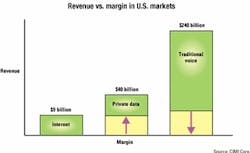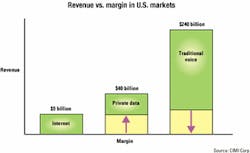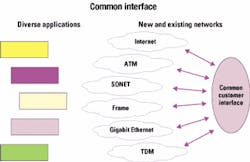Smart services, not fat pipes
The key to service-provider survival does not lie in the pursuit of ever-higher bandwidth, but in the ability to supply intelligent services.
JOHN HOLOBINKO, Aplion Networks
Bandwidth bonanza? How will service providers survive and endure? Whether incumbent or competitive, what capability will enable a carrier to prevail and prosper in this challenging communications marketplace? These are questions that possess a new urgency, as the telecommunications industry continues to undergo the dramatic changes observed since 1996, with the additional financial pressures witnessed in 2001. What is the answer? Does it lie in what many have stated-the pursuit of ever-higher bandwidth-"fat pipes?"
Indeed, claims have abounded, with the weekly prediction that the next new technology will cause the cost of bandwidth to plummet, promising a multitude of rewards for customers and service providers alike. However, the results just don't add up.
Much of the optimism is based upon a bandwidth model that says, "More is always better." But a business customer that is satisfied with its bandwidth cannot be sold more at any price. Moreover, with an array of service providers marketing mere bandwidth against one another, on not much other than price, customers have little incentive to stay with present suppliers-gladly listening to the next provider's sales pitch for an even lower price, resulting in customer churn rate that has skyrocketed 35 to 40% annually.Another fundamental point to ponder is that service providers survive on margins and profits-not just revenues. So there is concern all around when analysts point out that voice service revenues have peaked at about $240 billion in the United States, while at the same time, margins are declining (see Figure 1).
Voice call minute growth has also flattened, providing more proof that simply reducing the cost per minute no longer increases revenues. In fact, much of carrier voice profits are derived from enhanced services that have nothing to do with bandwidth, such as caller ID and call waiting.Meanwhile, Internet access, touted as the answer for provider profitability concerns, has clearly failed to meet those expectations. Despite the fact that demand for Internet access continues to rise, it still generates only $9 billion in revenues and little or no identifiable margin. Instead, the major ity of data-related revenues and profits are derived from private data services, such as frame relay and transparent LANs.
That seems to be the case even though the promise of the Internet access opportunity has for years been the primary driver for data infrastructure expenditures. So, although everyone recognizes the future potential of IP-based services, today they are simply not going to pay the service providers' bills.
Today, services are rigidly tied to specific network technologies and protocols. Moreover, each transport-type traditionally requires its own box. This ever-increasing complexity costs money-and plenty of it. But it's not just for the gear. In the neighborhood of 80% of service costs are attributable to operations and life-cycle costs-not equipment costs.
Moreover, there is evidence that services are provisioned correctly only a quarter of the time. Whether the network is fiber, copper, or hybrid fiber/coaxial, considering the present intricacies of provisioning each physical transport type and each service individually, it is no wonder that getting it right the first time is such a challenge.Clearly, it's being realized that for service providers, simply marketing commodity bandwidth is not a profitable endeavor. Lower prices don't gain all that many customers, and they certainly don't foster customer loyalty. Besides, it costs a lot of money to obtain customers-and where does that investment go when they leave for the first competitor to offer them a better deal? In that statement, the crux of the matter lies-what really constitutes a "better deal" for the customer, or for that matter, the provider?
Let's first talk about what the better deal is not. A better deal is not paying for more paid-up bandwidth when the customer only needs that big pipe for the weekly teleconference with the London office. A better deal is not having the customer pay for Internet access, and having its executive officer experience unsatisfactory net meeting performance be cause the shipping clerk is downloading streaming video during his break. A better deal is not providing a new service that requires the carrier to leave all of its legacy services and depreciated equipment behind.
The other side of the coin is an entirely new way of doing business in telecommunications-any service, to any customer, over any network (see Figure 2). It is founded upon a smart-service orientation. The backbone of this capability is an always-on, software-enabled network, resulting from the fusion of management software, intelligent programmable customer premise equipment, and highly programmable, next-generation multiservice switching. This combination is transport-agnostic. An immediate dividend is that the service providers' connection to the customer needs to be provisioned only once, regardless of what services are delivered across that connection in the future.
The result is a telecommunications world ready to support current services and service extension, plus mass-customized, value-added services that can be prioritized by user and billed by usage and priority, instead of commodity bandwidth. It's where the physical transport is straightforwardly provisioned, and services are so straightforward to manage that they can be test-marketed at the customer's facility on a trial basis and then made permanent or removed/replaced through simple software commands.
In this software-enabled, always-on network, services are marketed, sold, and activated at the speed of the marketplace. Meanwhile, the expensive truck rolls and expensive provisioning of the past are reduced or eliminated in the bargain.
When bandwidth is sold as a commodity, no one in the supply chain really receives full value. But when "dumb pipes" are turned into "smart services," everyone wins. A single, common interface is what the customer "sees" from the service provider-and it now becomes easy to develop and activate differentiated services that customers will pay for (see Figure 3).
In fact, any service-even services not conceived of today-can be delivered to any customer over any network, with priority to the individual desktop. At the same time, basing this shift in strategy upon software-controlled multiservice technology enables the network to provide more and better services with less network complexity. To the carrier's benefit, this approach leverages and extends the lifecycle of existing technology. Meanwhile, the overall advantages are plentiful (see Sidebar on this page).
For the service provider, entire new business models emerge as existing services and infrastructure are leveraged and enhanced. New, transport-independent services are straightforwardly developed and even test-marketed using a simple software interface, fueling even greater demand. As a new source of revenue, service providers will leverage their customer base as an asset, negotiating with application service providers and network service providers for the applications and connectivity they need to service those clients, while the entire physical and business process is transparent.
This new smart architecture allows a service provider to manage its business and leverage its assets on the supply and distribution sides as never before. Many more services are available and can be profitable at very low take-rates. Margins are increased as more value-added services are developed and marketed. Customer loyalty improves and churn is eliminated as a primary concern.
From the customer's perspective, there is now an array of data services delivering specific customer value much like the enhanced voice services, many of which seem to be custom-designed to individual needs. The service provider is no longer marketing mere commodity bandwidth, but rather partnering with the customer to evaluate, select, and integrate an entire suite of customized services. The provider can now be an applications and communications consultant to the customer, providing insight into future service options as the customer's business grows, instead of worrying endlessly about the next bandwidth price war.
The time has passed for commodity bandwidth. It is time to move from "dumb pipes" to "smart services" via software-enabled, next-generation, always-on, multiservice technology. For incumbent and independent providers, the opportunity now exists to use their current networks and a smart service strategy to move away from the price wars and toward highly profitable and differentiable services that provide direct customer value.
John Holobinko is president and CEO at Aplion Networks (Edison, NJ). He can be reached via the company's Website, www.aplion.com.
When "dumb pipes" are turned into "smart services," everyone wins. Any service, even services not conceived of today, can be delivered to any customer, over any network, with priority to the individual desktop. Software-enabled multiservice technology allows the network to provide more and better services with less network complexity. To the carrier's benefit, this approach leverages and extends the lifecycle of existing technology, while offering numerous other advantages:
- Dynamic creation and activation of services via software.
- Existing infrastructure and native services are extended and enhanced, while still using existing network infrastructure.
- Mass-customized, value-added services billed by usage and priority of service.
- Improved time-to-market for new and enhanced services.
- Improved take rates for new, higher-margin services.
- Free new service trials without truck rolls.
- Content- and application-aware network and management.
- Prioritized traffic management to the desktop.
- Entire suite of services becomes much easier to manage.
- Greater customer satisfaction and lower churn.
- Reduced network complexity through multiservice capability.
- Improved equipment lifecycles due to programmability.
- Simplified integration of new services on current network infrastructures.
- Extension to existing services (e.g., frame relay, transparent LANs) with application prioritization.
- Internet/e-mail access control.
- Access prioritization by group or even to the user desktop.
- Priority access during times of congestion.
- Dynamic bandwidth allocation.
- Remove server responsibility from customer.
- Prioritization to the desktop level.
- Low priority remote data archive.
- Combination firewall, addressing, and private network with easier management.
- Consistent performance independent of network congestion.
- Priority to each customer's requirements.
- High-speed software download.
- Remote storage networks.
- Low cost with no additional equipment.
- Prioritization of traffic over virtual private networks.
- Video-conferencing and net meetings.
- Block delivery of undesirable services.
- T-card systems control.
- Remote video surveillance and archival.
- Physical asset and capital equipment control.
- Dynamic control over number of lines.
- Able to prioritize multiprotocol traffic now and in the future (ATM, IP, TDM, etc.).
- Coordination with softswitch resources.



